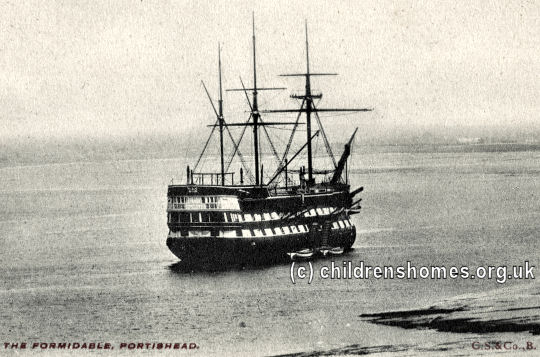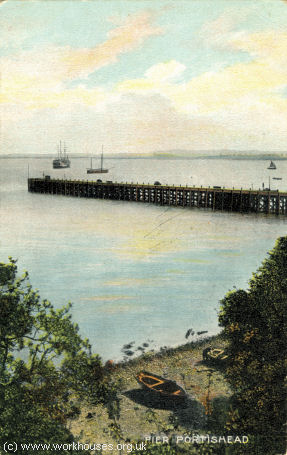Industrial School Ship 'Formidable', Bristol, Gloucestershire
The Formidable was leased from the Admiralty in 1869 for use as a training ship in a scheme financed by several Bristol businessmen, led by Mr Henry Fedden, who were concerned about the high numbers of urchins wandering the city's streets. The vessel was moored at Portishead in the Bristol Channel, and anchored about four hundred yards off the pier. Much of the cost of her conversion, around £3,000, was raised by organising excursions out to the ship for local people.

Training Ship Formidable. © Peter Higginbotham
The ship could accommodate up to 350 boys aged from 11 to 14, the first of whom arrived in December 1869. The official opening was performed by the Reverend Charles Kingsley, author of Westward Ho! and The Water Babies.

Portishead Pier, early 1900s. © Peter Higginbotham
On November 18th, 1869, the Formidable was certified as an Industrial School Ship, allowing it to take children committed by the courts. The ship had a tender, 'Polly', which was similarly certified on February 27th, 1875.

Tender Polly. © Peter Higginbotham
By July 1872, 235 boys had been received, of whom six had been placed the Royal Navy, seven had been sent to sea as ordinary seamen, 28 had been apprenticed in the merchant service, two had been sent sea as ship boys, and three had emigrated to America with the assistance of the association. In addition to the ordinary instruction, the boys were taught tailoring, shoemaking, etc., and, thanks to the assistance of several gentlemen, a brass band was established on board. In 1881 two other important additions were made to the institution in the shape of a floating swimming bath, and cottage hospital on shore for the accommodation of sick boys. On 10 November 1881, the Admiral Superintendent, His Royal Highness the Duke Edinburgh,visited the Formidable in his official capacity, and reported that the ship was very clean and in good order, and that the boys appeared healthy and intelligent, and performed their drills and exercises in a satisfactory manner. At this date there were 360 inmates, and at the end of 1881 the total admissions from the commencement of the institution had been 1,251. Of these 561 had gone to sea in the merchant service, 52 in the Royal Navy, 116 had been found employment in other ways, had been handed over to their friends, had been transferred to other institutions, 14 had joined the Army, 13 had emigrated, 24 had died, and there were remaining on board at the end of December 1881, 351 boys. In 1882, a gymnasium was added on board in order to improve the health and physique of the boys
After rising at 6 a.m. in the summer, and 6.30a.m. in the winter, the daily routine began. Hammocks, which had been suspended from the beams, were lashed and stowed away and mess tables took their places. Breakfast consisted of hot cocoa and milk, with a hunch of bread. Immediately after breakfast the decks were all washed perfectly clean. The order "hands to dress" was then given, when every boy washed and presented himself for inspection at divisions at 8.30, when the officers examine if they are all fit for the captain's inspection, or, in his absence, the chief officer. After the inspection, the band, which had been playing while the boys were at divisions, struck up a march, and all hands repaired to the main deck, where a bell tolled solemnly for prayers, which were read by the captain. After prayers all dispersed until five minutes to nine o'clock, when they again fell-in, one half, or "Watch," assigned to the school, and the others to their various instructions seamanship, boating, swimming, band, rifle, and sword exercises, besides tailoring, carpentry, and hair-cutting. At 10.30, the signal was given to "Stand easy" for five minutes, a brief playtime, after which a stroke of the bell marked a return to their respective duties. At 11.45 the "watch"on deck was dismissed from instruction to clear and sweep the decks thoroughly clean. the bugle then sounded for the cooks of messes to prepare for dinner, their duty being to bring it up from the galley and divide into equal portions. Each mess composed of about 16 boys, was presided over by a petty officer, called "captain of his mess," who was responsible for its order and cleanliness, and for reporting any irregularities or disobedience of orders to the officer who walked up and down the lower deck meal times. At 12 o'clock, according naval precedent, the boatswain's mate "piped to dinner," and all bands fell in on the lower deck abreast of their messes facing inboard. After grace was said or sung, the order was given to sit down, and dinner was eaten in silence. After dinner, the order was given to "Rise." Grace was then either said or sung, and the boys were allowed to play about one o'clock. A similar routine began as in the forenoon, except that the watches were changed, the school party learning seamanship, etc. and the others going down to school until four o'clock, when the day's work ended. The mess tables are again put in order and cans of cocoa, enriched with new milk and sugar, were served out, together with a hunch of bread to each boy. The time after "tea," and when the decks are swept perfectly clean, was given over to amusement. The boys turn into their hammocks about nine o'clock, after prayers, closing the day with prayers. On Sundays, no work was done that could be dispensed with, and more time was devoted to prayers, the singing of hymns, etc.
So that the boys might be more thoroughly instructed in seamanship, a system of teaching them by means of models was inaugurated. Models similar to those used on board the Impregnable were obtained, and by this means the inmates of the ship gained practical acquaintance with the work of a sailor. On the main deck was a model of a bowsprit on which the mode of rigging demonstrated, and the same deck a section of the boys were instructed in the details of the work connected with the setting of sails, etc. On the orlop deck was a model illustrating the latest improvements in casting and lifting anchors, another for instruction in the bearings of the compass, and a third took the form of a ship working on pivot, to exemplify the influence of the wheel in determining the course of vessel. In case of wet weather, to allow the full course of seamanship instructions to be continued, there was model of a full-rigged ship, complete in all its details, and there was a model of a mast rising from the orlop deck. When the guns on board became out of date, training in heavy gun-drill was replaced by rifle and cutlass drill.
In the cook's galley on the main deck, the food was cooked by steam. Cooked food was lowered from the galley into the dining-room through a trap door close to the cooking apparatus. A reading room was provided in which boys could pass their time. In 1882, a gymnasium was installed measuring 50 feet long, 30 feet wide and 10 feet high, which was also used for entertainments. The band, numbering about 40 boys, added to the enjoyment of life on board the ship and the musical training it provided enabled several boys to enter military bands after leaving the Formidable. The band also gave performances on shore.
The Formidable was withdrawn from service by the Admiralty early in 1906 after suffering damage in strong gales. The vessel was replaced by a new shore establishment known as the Incorporated National Nautical School at Portishead.
Records
Note: many repositories impose a closure period of up to 100 years for records identifying individuals. Before travelling a long distance, always check that the records you want to consult will be available.
- Bristol Record Office, 'B' Bond Warehouse (in the 'Create Centre' section from 3-Dec-2013), Smeaton Road, Bristol BS1 6XN. Holdings include: Annual reports (from 1875, with gaps); Register of boys (from 1878).
Census
Bibliography
- Carridice, Phil Nautical Training Ships: An Illustrated History (2009, Amberley Press)
- Higginbotham, Peter Children's Homes: A History of Institutional Care for Britain's Young (2017, Pen & Sword)
Links
- None identified at present.
Except where indicated, this page () © Peter Higginbotham. Contents may not be reproduced without permission.


